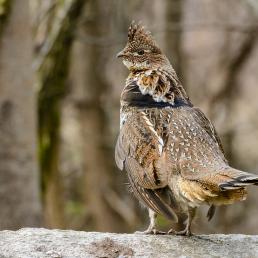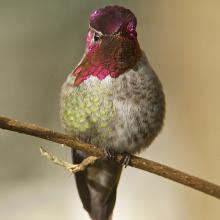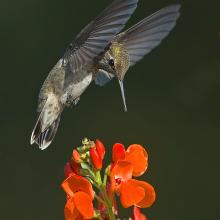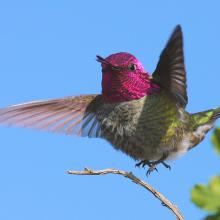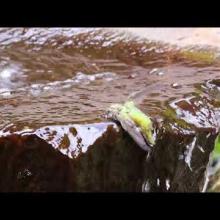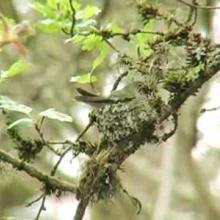

Join BirdNote tomorrow, November 30th!
Illustrator David Sibley and actor H. Jon Benjamin will face off in the bird illustration battle of the century during BirdNote's Year-end Celebration and Auction!
Most hummingbirds retreat south in autumn, but Anna's Hummingbirds are found in northern latitudes throughout the year. Since 1960, they've moved their year-round limit north from California to British Columbia. They're taking advantage of flowering plants and shrubs, as well as hummingbird feeders. But how do they survive the northern cold? They suspend their high rate of metabolism by entering a state of torpor – a sort of nightly hibernation, where heart rate and body temperature are reduced to a bare minimum. Many hummingbirds, including those in the high Andes, rely on the same strategy.
BirdNote®
Anna’s Hummingbirds Winter in the North
Written by Bob Sundstrom
This is BirdNote.
[Male Anna’s Hummingbird singing]
On a chilly February morning near Seattle, with the temperature hovering below 40 degrees, a bird is singing lustily. [Male Anna’s Hummingbird singing] And not just any bird. It’s a hummingbird! A male Anna’s Hummingbird, whose throat and crown flash iridescent rose. [Male Anna’s Hummingbird singing]
But what is a hummingbird doing this far north in winter?
While most hummingbirds retreat south in autumn, Anna’s are found in northern latitudes throughout the year. Since 1960, they’ve moved their year-round limit north from California to British Columbia. They’re taking advantage of widely planted flowering plants and shrubs as well as hummingbird feeders.
But how do they survive the northern cold? They seem unlikely pioneers, since hummingbirds have no down feathers for insulation and a metabolism that runs so high that they would exhaust their energy reserves on a cold night.
[Cold winter wind ambient]
The hummingbird’s solution? Suspend that high rate of metabolism by entering a state of torpor – a sort of nightly hibernation, where heart rate and body temperature are reduced to a bare minimum. Many hummingbirds, such as those residing in the high Andes, rely on the same strategy.
Yes, Anna’s Hummingbird has come north to stay. [Wing whir of male Anna’s Hummingbird] And its jewel-like presence at the nectar feeder adds sparkle to any winter day.
[Wing whir of male Anna’s Hummingbird]
For BirdNote, I’m Mary McCann.
###
Bird sounds provided by The Macaulay Library at the Cornell Lab of Ornithology, Ithaca, New York. Wing whir recorded by David Allen [6121]. Male Anna's Hummingbird song [111006] recorded by T.G. Sander.
Winter ambient C Peterson and Kessler Productions
Producer: John Kessler
Executive Producer: Chris Peterson
© 2013 Tune In to Nature.org February 2017/2019/2022 Narrator: Mary McCann
ID# ANHU-03-2013-02-13
